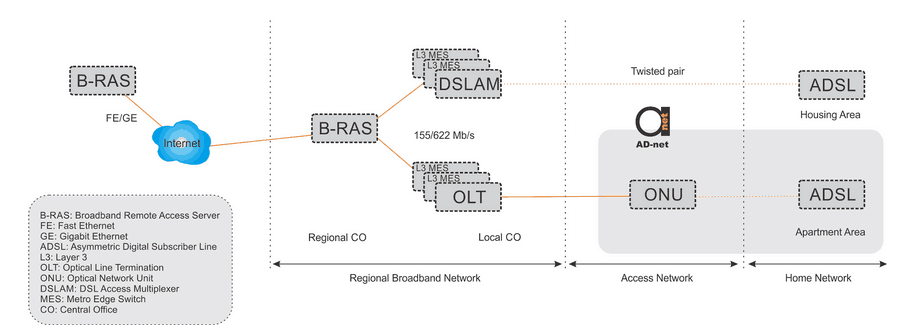The cellular services started spreading very fast, resulting in decreasing of the local and long-distance phone traffics. This forced companies to develop new engines, beyond the telephone lines. Large companies started by introducing ISDN based Internet access service with a speed of 128 kbps. Nevertheless, that service could not satisfy customers that were using it for multimedia purposes. That was one of the main reasons for choosing ADSL as the main broadband Internet technology, in 2000. Even after 12 years, ADSL-based access service occupies the largest portion of the current broadband market.

Figure 1. Two types of ADSL network.
Two kinds of ADSL networks are shown on the Figure 1. The first one is called CO-ADSL and is designed in the way, that DSL access multiplexers (DSLAMs) are allocated at the central office and users are connected through the twisted pairs directly to the CO. Drawback of this design, is impossibility to use it for the premises allocated in more than 3 km from the CO. At the moment of this technology introduction, only 20% of all the customers were falling into this category, so most of the installed lines were CO-ADSLs.
Second type of ADSL is based on fiber to the curb (FTTC). This design serves for the residential areas that are allocated in more than 3 km from the CO and for the apartment areas to avoid degradation of the ADSL quality. This design is placing OLT in the CO and ONU into the apartment areas. At that point of time, access networks are based on ADSL and ATM, emerging to the broadband based on IP, Ethernet and VDSL.
The success of the ADSL network is highly dependant on maintenance and provisioning capabilities of the service. Service quality maintenance activities should performed on time and proactively. Shortening the delay between the service request and actual provisioning is crucial for the success.
It is critical requirement for successful maintenance having interoperable devices in the network, even if they are produced by different vendors. Interoperability will result in additional costs when a device needs to be replaced. Another source of problems and additional costs is the customer’s PC. Most of the problems for the customer usually are coming from customer PC and it is important for the service provider to be able to provide remote maintenance.


